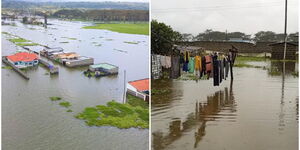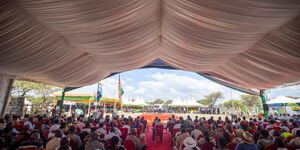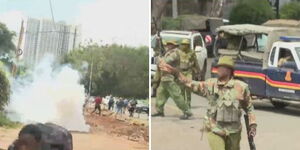Kwale police have killed on Saturday, May 30, two children aged six and three who police said were being used as human shield by a suspected al-Shabaab terrorist.
An elite team of police officers stormed a house in Kibundani, Diani where they suspected Mohamed Mapenzi, a wanted terror suspect was hiding.
During the raid in the wee hours of the morning, the police were surprised to find that he was already aware of the officers' plans.
“As the officers were preparing to break into the suspect’s house, he suddenly opened the door and threw a grenade at them slightly injuring one of them,” reads the police report.
A fierce shoot out ensued and Mapenzi grabbed two children whom he used as human shields.
As the shootout ensued, the officers killed the terror suspect alongside the two children.
Three other children and the suspect’s wife were rushed to Msambweni Referral Hospital. It is believed that the house was an al-Shabaab recruitment hideout.
A former elite GSU officer who spoke to Kenyans.co.ke stated that police should have refrained from shooting the minors.
“When they were used as a human shield, the officers shouldn’t have shot them. They should have engaged the terrorist in alternative ways to ensure the safety of the minors,” he spoke on the phone.
A grenade and jungle uniforms were recovered from the house, where police had been led to by Saidi Chitswa alias Ninja, who is a suspected Al Shabaab recruiter.
According to a study by The Network for Religious and Traditional Peacemakers, effective counter-radicalisation strategies should be based on an empirical understanding of why people join terrorist organisations.
Researchers interviewed former Al-Shabaab fighters and identified a complex array of reasons for why they joined the organisation.
The factors included religious identity, socioeconomic circumstances (education, unemployment), political circumstances and the need for a collective identity and a sense of belonging.
During the period between 12 and 22 years, people are at their most impressionable stage in life and most open to outside influence because they are both becoming increasingly aware of the social and political world around them as well as establishing their own identities.
A good number of the terror group’s members are Kenyans and it is therefore essential that security agencies in Kenya move away from the perception that only Somalis are involved with al-Shabaab.
It was established that two of the Dusit D2 terror attack were from Kiambu and Nyeri counties.
26-year-old Eric Kinyanjui origin was traced to Ngecha Village in Limuru, and Farouk was reportedly born and bred in Majengo slum in Nyeri.












